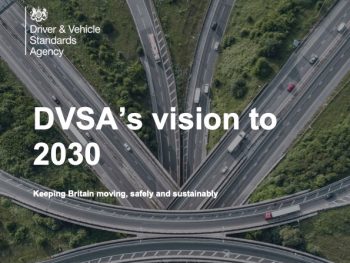DVSA 2030 vision recognises rise of autonomous vehicles
The Driver and Vehicle Standards Agency (DVSA) has published its vision to 2030, setting out its work to ensure road transport is greener and safer.

The vision recognises that electric and self-driving vehicles, along with connected vehicles and roads, will help protect from injury, death, pollution and climate change
The document sets out five key challenges that the agency is working to address with its partners:
- Make roads safer
- Improve services for its customers
- Make road transport greener and healthier
- Harness the potential of technology and data
- Grow and level up the economy
The vision recognises that electric and self-driving vehicles, along with connected vehicles and roads, will help protect from injury, death, pollution and climate change. It also seeks to transform services to be more efficient and simpler to use.
Core targets for 2030 include:
- Adapting driving standards for vehicles with self-driving features
- Adapting theory tests and driving tests for vehicles with self-driving features
- Making it more convenient to take theory tests and driving tests
- Reviewing the MOT model for HGVs, buses and trailers
- Making sure vehicle approval tests allow new vehicle technology to be trialled and rolled out across the country
- Making the best use of data and technology to improve standards of MOT testing and driving instruction
The work will help ensure taking theory tests and driving tests becomes more convenient and that both new and existing drivers are able to use self-driving vehicles safely. The DVSA will also explore how MOT testing and in-service vehicle safety can keep up with the latest vehicle technology, such as artificial intelligence, radar and LiDAR.
The plans also bring a focus on commercial vehicle operators, including that they have clear standards to follow which reflect the latest technology, access to tailored guidance and that more commercial driver and vehicle non-compliance is detected remotely through better data and technology.
The 2030 vision is accompanied by a strategic plan to 2025 while the business plan for 2023 to 2024 will be published later this spring.
Loveday Ryder, DVSA chief executive, said: “The transformative plans in these documents demonstrate our drive for more efficient services. We will always keep looking for ways to build on this to support the Government’s ambitions.”
Business group Logistics UK said the 2030 vision was “encouraging” and greeted points such as maintaining the increased numbers of vocational HGV tests.
Phil Lloyd, head of engineering policy, added: “Also within the vision document is the recognition that autonomous vehicles will play a much larger role moving forward, and it is therefore encouraging that DVSA is already thinking about how it will reach its goal of road safety within this new environment. Logistics UK also welcomes the forward-thinking approach to using datasets to identify root causes of issues to improve compliance and looks forward to continuing to support DVSA deliver its vision.”
The BVRLA also welcomed the insight into the DVSA’s vision and said it looked forward to working with the organisation on implementation.












